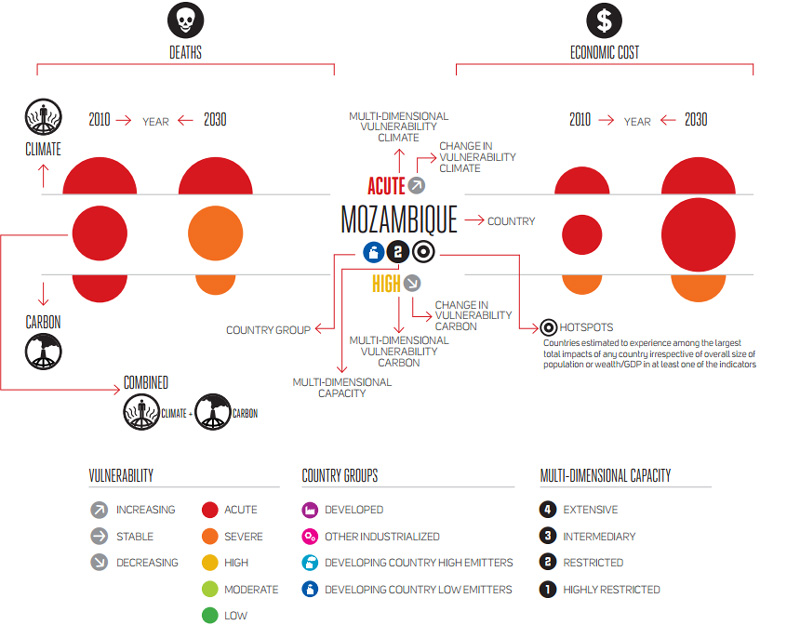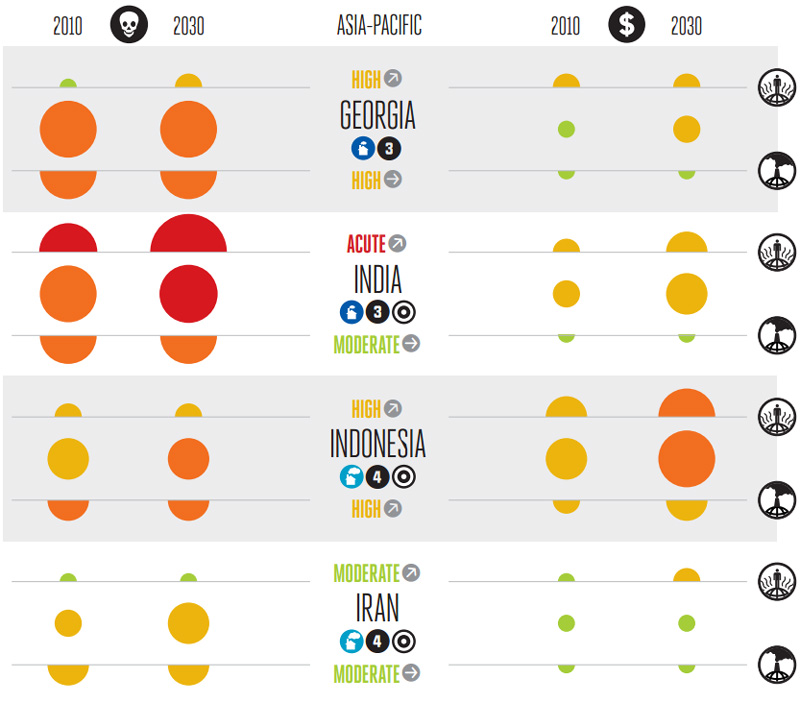-
Does Climate Change Kill Five Million People A Year? DARA’s 2012 Climate Vulnerability Monitor
Five million people die each year due to climate- or carbon-related causes, and total mortality by 2030 could total 100 million people, according to new report from DARA, a nonprofit organization that works to improve aid to those affected by conflict and climate change and quantify the global cost of climate change and carbon use. But the report has drawn some fire for being too alarmist.
A Window Is Closing Fast
Climate change “takes the most from those who have the least,” write the authors of the 2012 Climate Vulnerability Monitor. According to their estimates, climate change and the carbon-based economy together cost the world more than $1.2 trillion in 2010, or 1.6 percent of global GDP, because of the increased severity of natural disasters; environmental changes like desertification, permafrost melt, sea level rise and loss of biodiversity; heating and cooling costs; and declines in labor productivity.
GDP losses for the least developed countries are estimated at 10 percent for 2010, significantly higher than global losses. Furthermore, many of the projected deaths will be children who are more vulnerable to factors like hunger, diarrheal diseases, malaria, and respiratory illness, and who bear “virtually no responsibility” for the current climate and carbon situation, as the authors put it.
DARA’s intention is to inform the public of the current impact of climate and carbon on the global population and economy, and to warn of the consequences of continuing down the same path:
There is still a window of opportunity, fast closing, to scale back pollution and tame the rising heat. But the world economy is locked onto a different course: fossil fuel consumption is expected to continue its rapid growth in the coming decades…The cold calculus of a hot planet is that millions of people already suffer from the failure of the world economy to embark on a low-carbon transition.
In addition to examining global and regional trends, the report also assesses a variety of vulnerability factors for 184 countries, comparing the situation in 2010 to projected costs for 2030. The graphics are useful for comparing changes over time, but not so much if you want to get a clear idea what is happening in a certain place. Vulnerability, for example, is broken into seven categories ranging from “low” to “acute +” but no rationale is given for each category. Similarly, “multidimensional capacity” ranks on a scale of one to four, with no explanation of that scale or even a definition for “multidimensional capacity.” The layout and circles motif of the index also makes it difficult to easily interpret and compare different countries to one another.
Also included is a more nuanced look at the situation in Ghana and Vietnam to demonstrate how the monitor can be used at the national level. These analyses include a greater breakdown of data, and also provide information about the current national responses, assets, and gaps in national and international funding and policy.
The Energy Economy = Climate Change?
This is actually the second edition of DARA’s climate vulnerability monitor, and the difference between this and the first has generated some controversy.
The 2010 version projected 350,000 deaths per year due to climate change in 2010, rising to 800,000 deaths per year by 2030. While hundreds of thousands of deaths are hardly trivial, this is a far cry from the 100 million deaths by 2030 anticipated in the 2012 version.
The dire projections have generated significant media interest and inspired shocking headlines and sharp rebuttals.
The contrast between the two reports is not due to a major change in the climate, but because of a change in focus. The new report measures the impact of both climate change and the carbon economy – that is, “the carbon-intensive energy system and related activities.” Most of the projected deaths in the 2010 report were caused by malnutrition, diarrhea, and malaria, conditions which can be exacerbated by climate change. The 2012 report, on the other hand, projects 400,000 deaths per year due to climate change but 4.5 million deaths because of the carbon economy, mainly due to pollution and cancer.
So, no, climate change does not kill five million people a year. But the carbon economy gets pretty close, according to DARA.
Still, estimating climate-related deaths is a thorny and inexact science, and the change in methodology has also drawn criticism.
Bjørn Lomborg, noted skeptic and author of The Skeptical Environmentalist, called the report “dramatically misleading” in an article published in Foreign Policy:
Indeed, 1.4 million deaths are caused by outdoor air pollution, which is almost entirely unrelated to global warming. This air pollution, of course, is still predominantly caused by fossil fuels, but only because that is what we mostly use for fuel in the world. So, while the report is technically correct in saying that these 1.4 million deaths are caused by “the present carbon-intensive economy,” these deaths are in no way caused by climate change. Rebranding air pollution, mostly from particulate pollution, as “carbon” appears both disingenuous and designed to confuse. It was clearly intended to convey the message that these deaths were somehow relevant for the global warming debate.
Tim Worstall, a fellow at the libertarian-leaning Adam Smith Institute, also takes issue with the fundamentals behind the report. “We must…consider the benefits as well as those costs,” he wrote for Forbes, “and that is precisely what this report does not do. Which is really not very good at all for it is the basic insight of economics that there is no such thing as a solution: there are only trade-offs.”
Matthew McKinnon, head of DARA’s Climate Vulnerability Initiative, defended the report in Foreign Policy in response, saying that carbon emissions – including mortality-causing pollution – contribute to climate change and it is therefore natural to include them in an analysis of climate change, just as carbon fertilization is often considered a potential benefit of climate change:
Our simple suggestion is that either you take all relevant impacts tied to the causes of climate change into account, or you take none of them. Our report separates out both issues to enable independent examination. Is this deliberately misleading, as Lomborg suggests? No, it is clarification: Considering only carbon fertilization without other non-weather effects only distorts the true costs of climate change.
McKinnon also emphasizes that the report is optimistic, not alarmist. Since effectively addressing climate change and carbon will prevent the loss of trillions of dollars and millions of lives, “we can deal with climate change, save millions of human lives, help slow rapid environmental degradation, rescue lagging progress on poverty reduction, and actually make money in the process.”
Reverse Tribalism
Assigning blame to climate change for anything will always be difficult – there is after all no other baseline Earth to compare to. But scientific consensus is that climate change is happening and many of its predicted effects have been observed, including stronger storms, more frequent droughts, and higher temperatures. Assigning blame to the carbon-based economy carries the same basic challenge for the seeming ubiquity of its causes and effects.
Nonetheless, determining the consequences of staying the course is an important task for those calling for change, especially if that change will be exacting and costly. The only way to spur action is to prove that inaction will have greater costs than action.
Of course, it is also important to make sure these consequences are calculated to the best of our ability. Independent commentary can provide the reader with broader context for new research, but there is also a tendency to go too far, especially in the climate community, a phenomenon Thomas Crowley, a retired climate scientist, has called “reverse tribalism.” Crowley used the term in a letter to The New York Times’ Andy Revkin to describe the “knee-jerk reaction towards invoking natural variability” following major weather events as a way to preemptively respond to climate skeptics. He argues that while “climate hysteria” is far from helpful – a point Max Boycoff and others have also made – neither is reflexively rejecting climate change as the distal cause of such events.
The same logic applies to the Climate Vulnerability Monitor. While some may criticize DARA for overreaching in the impacts they ascribe to climate change and the carbon economy, it is crucial to recognize that the factors they measure are connected to one another and do adversely affect the health and economic stability of countries around the world. It’s true that the carbon-free world DARA uses as its baseline is not yet achievable and may never be, but the report demonstrates that working to reduce reliance on carbon as much as possible has tangible benefits across people’s lives. And, perhaps just as importantly, that there will be severe consequences should we continue on the same track.
Sources: Bloomberg, DARA, Dot-Earth, Forbes, Foreign Policy, Grist, The Huffington Post, The Independent.
Image Credit: The Climate Vulnerability Index/DARA.
 A Publication of the Stimson Center.
A Publication of the Stimson Center.





